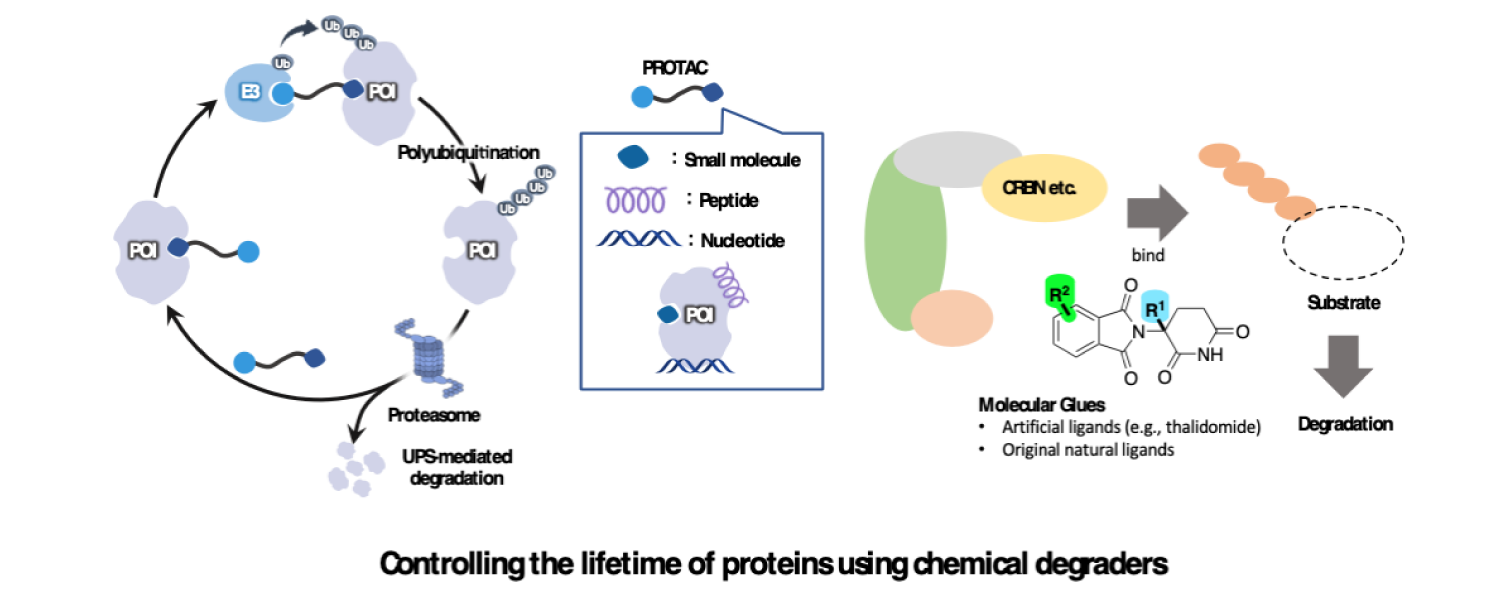A03-3
Controlling the lifetime of proteins using small-molecule degraders

Yosuke Demizu
Division of Organic Chemistry, National Institute of Health Sciences
http://www.nihs.go.jp/doc/
researchmap: https://researchmap.jp/read0105922
Takumi Ito
Institute of Medical Science, Tokyo Medical University
Division of Organic Chemistry, National Institute of Health Sciences
http://www.nihs.go.jp/doc/
researchmap: https://researchmap.jp/read0105922
Takumi Ito
Institute of Medical Science, Tokyo Medical University
Abstract
This research group will utilize chemical-based protein knockdown technologies to conduct chemical biology research that can artificially control the lifetime of proteins. In particular, we aim to develop next-generation PROTACs and Molecular Glues that enable spatiotemporal control at the intracellular protein level. In addition, we plan to clarify the original function and physiological role of cereblon (CRBN), to elucidate its effects and interference with drug binding, and to attempt to analyze and elucidate the function of E3 adaptor proteins other than CRBN. Furthermore, we aim to develop thalidomide-type PROTACs and Molecular Glue Degraders that avoid the degradation of teratogenic neosubstrates.

- Takada H, Tsuchiya K, *Demizu Y Helix-stabilized cell-penetrating peptides for delivery of antisense morpholino oligomers: Relationships among helicity, cellular uptake, and antisense activity Bioconjug. Chem. 38, 1311-1318 (2022).
- Naganuma M, *Ohoka N, Tsuji G, Tsujimura H, Matsuno K, Inoue T, Naito M, *Demizu Y Development of chimeric molecules that degrade the estrogen receptor using decoy oligonucleotide ligands ACS Med. Chem. Lett. 13, 134-139 (2022).
- Yamamoto J, Ito T, Yamaguchi Y, *Handa H. Discovery of CRBN as a target of thalidomide: a breakthrough for progress in the development of protein degraders. Chem. Soc. Rev. 51, 6234-6250 (2022).
- Yokoo H, *Shibata N, Endo A, Ito T, Yanase Y, Murakami Y, Fujii K, Hamamura K, Saeki Y, *Naito M, *Aritake K, *Demizu Y Discovery of a highly potent and selective PROTAC targeting hematopoietic prostaglandin D synthase via in silico design J. Med. Chem. 64, 15868-15882 (2021)
- Yokoo H, Ohoka N, Takyo M, Ito T, Tsuchiya K, Kurohara T, Fukuhara K, Inoue T, Naito M, *Demizu Y Peptide stapling improves the sustainability of a peptide-based chimeric molecule that induces targeted protein degradation Int. J. Mol. Sci. 22, 8772 (2021).
- Shimizu N, Asatuma-Okumura T, Yamamoto J, Yamaguchi Y, *Handa H, *Ito T PLZF and its fusion proteins are pomalidomide-dependent CRBN neosubstrates Commun. Biol. 4, 1277 (2021).
- Ito T, Yamaguchi Y, *Handa H. Exploiting ubiquitin ligase cereblon as a target for small-molecule compounds in medicine and chemical biology Cell. Chem. Biol. 28, 987-999 (2021).
- Okitsu K, Hattori T, Misawa T, Shoda T, Kurihara M, *Naito M, *Demizu Y Development of a small hybrid molecule that mediates degradation of His tag-fused proteins J. Med. Chem. 61, 576-582 (2018).
- Matyskiela M E, *Lu G, Ito T (co-1st author), Pagarigan B, Lu C C, Miller K, Fang W, Wang N Y, Nguyen D, Houston J, Carmel G, Tran T, Riley M, Nosaka L, Lander G C, Gaidarova S, Xu S, Ruchelman A L, Handa H, Carmichael J, Daniel T O, Cathers B E, Lopez-Girona A, *Chamberlain P P. A novel cereblon modulator recruits GSPT1 to the CRL4(CRBN) ubiquitin ligase Nature 535, 252-257 (2016).
- Ito T, Ando H, Suzuki T, Ogura T, Hotta K, Imamura Y, Yamaguchi Y, *Handa H. Identification of a primary target of thalidomide teratogenicity Science 327, 1345-1350 (2010).
